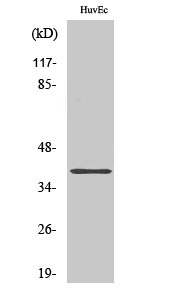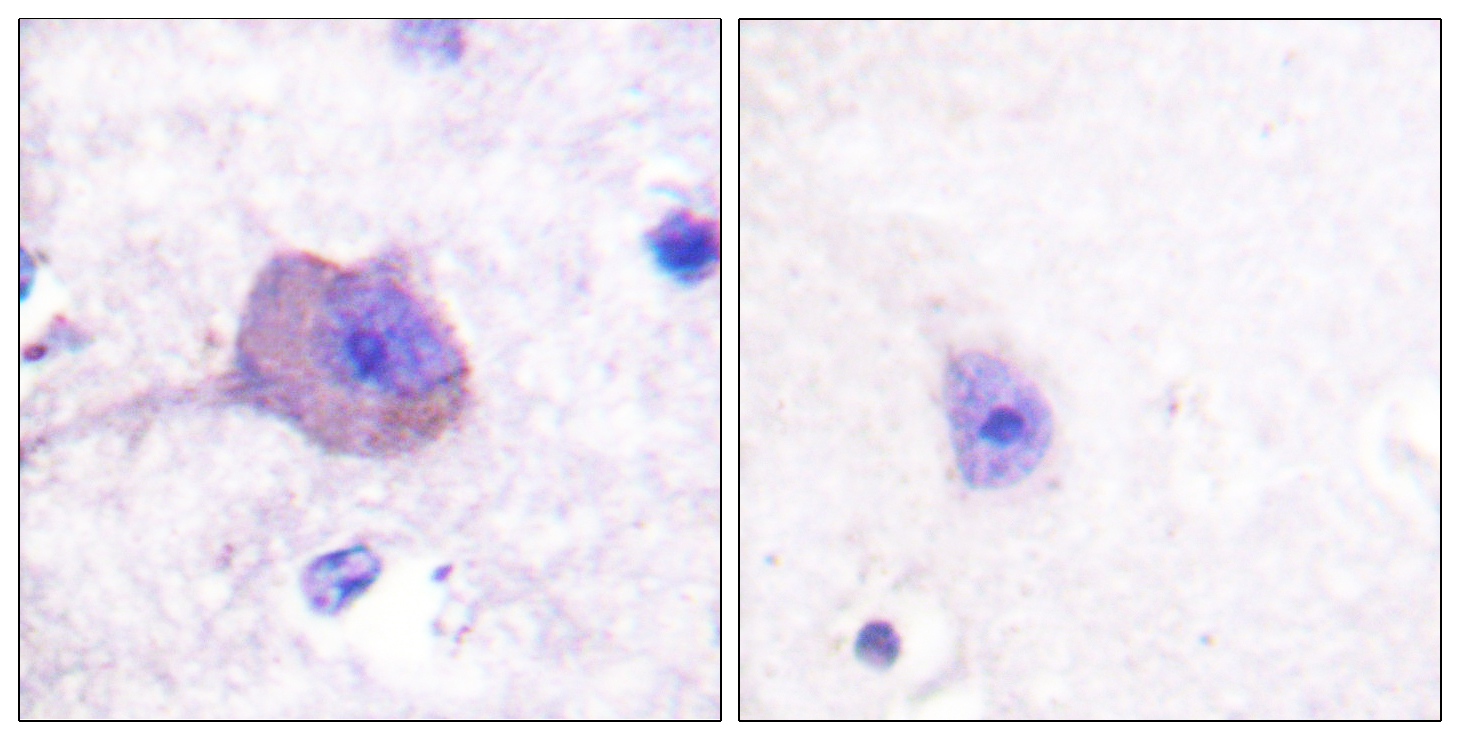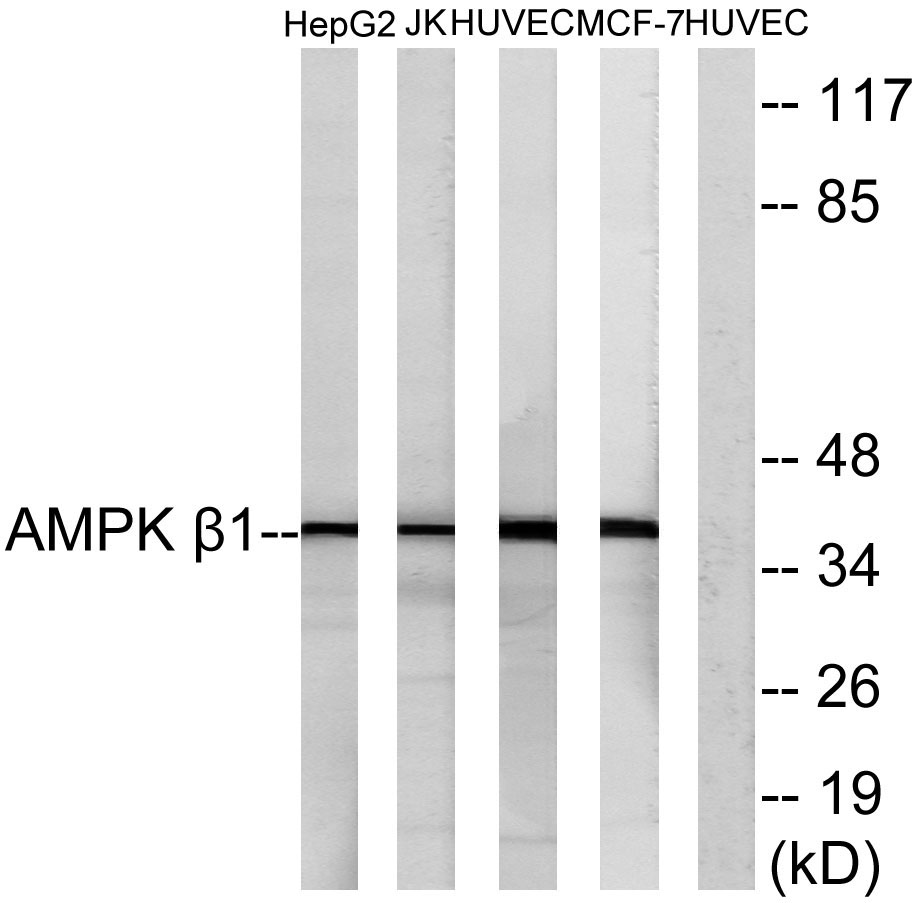AMPKβ1 Polyclonal Antibody
- Catalog No.:YT0218
- Applications:WB;IHC;IF;ELISA
- Reactivity:Human;Mouse;Rat;Monkey
- Target:
- AMPKβ1
- Fields:
- >>FoxO signaling pathway;>>AMPK signaling pathway;>>Longevity regulating pathway;>>Longevity regulating pathway - multiple species;>>Apelin signaling pathway;>>Tight junction;>>Circadian rhythm;>>Thermogenesis;>>Insulin signaling pathway;>>Adipocytokine signaling pathway;>>Oxytocin signaling pathway;>>Glucagon signaling pathway;>>Insulin resistance;>>Non-alcoholic fatty liver disease;>>Alcoholic liver disease;>>Hypertrophic cardiomyopathy
- Gene Name:
- PRKAB1
- Protein Name:
- 5'-AMP-activated protein kinase subunit beta-1
- Human Gene Id:
- 5564
- Human Swiss Prot No:
- Q9Y478
- Mouse Gene Id:
- 19079
- Mouse Swiss Prot No:
- Q9R078
- Rat Gene Id:
- 83803
- Rat Swiss Prot No:
- P80386
- Immunogen:
- The antiserum was produced against synthesized peptide derived from human AMPK beta1. AA range:147-196
- Specificity:
- AMPKβ1 Polyclonal Antibody detects endogenous levels of AMPKβ1 protein.
- Formulation:
- Liquid in PBS containing 50% glycerol, 0.5% BSA and 0.02% sodium azide.
- Source:
- Polyclonal, Rabbit,IgG
- Dilution:
- WB 1:500 - 1:2000. IHC 1:100 - 1:300. ELISA: 1:20000.. IF 1:50-200
- Purification:
- The antibody was affinity-purified from rabbit antiserum by affinity-chromatography using epitope-specific immunogen.
- Concentration:
- 1 mg/ml
- Storage Stability:
- -15°C to -25°C/1 year(Do not lower than -25°C)
- Other Name:
- PRKAB1;AMPK;5'-AMP-activated protein kinase subunit beta-1;AMPK subunit beta-1;AMPKb
- Observed Band(KD):
- 38kD
- Background:
- The protein encoded by this gene is a regulatory subunit of the AMP-activated protein kinase (AMPK). AMPK is a heterotrimer consisting of an alpha catalytic subunit, and non-catalytic beta and gamma subunits. AMPK is an important energy-sensing enzyme that monitors cellular energy status. In response to cellular metabolic stresses, AMPK is activated, and thus phosphorylates and inactivates acetyl-CoA carboxylase (ACC) and beta-hydroxy beta-methylglutaryl-CoA reductase (HMGCR), key enzymes involved in regulating de novo biosynthesis of fatty acid and cholesterol. This subunit may be a positive regulator of AMPK activity. The myristoylation and phosphorylation of this subunit have been shown to affect the enzyme activity and cellular localization of AMPK. This subunit may also serve as an adaptor molecule mediating the association of the AMPK complex. [provided
- Function:
- function:AMPK is responsible for the regulation of fatty acid synthesis by phosphorylation of acetyl-CoA carboxylase. Also regulates cholesterol synthesis via phosphorylation and inactivation of hydroxymethylglutaryl-CoA reductase and hormone-sensitive lipase. This is a regulatory subunit, may be a positive regulator of AMPK activity. It may also serve as an adaptor molecule for the catalytic alpha-subunit.,PTM:Phosphorylated.,similarity:Belongs to the 5'-AMP-activated protein kinase beta subunit family.,subunit:Heterotrimer of an alpha catalytic subunit, a beta and a gamma non-catalytic regulatory subunits. Interacts with FNIP1 and FNIP2.,
- Subcellular Location:
- nucleus,nucleoplasm,cytosol,nucleotide-activated protein kinase complex,
- Expression:
- Brain,Lung,Muscle,Platelet,
- June 19-2018
- WESTERN IMMUNOBLOTTING PROTOCOL
- June 19-2018
- IMMUNOHISTOCHEMISTRY-PARAFFIN PROTOCOL
- June 19-2018
- IMMUNOFLUORESCENCE PROTOCOL
- September 08-2020
- FLOW-CYTOMEYRT-PROTOCOL
- May 20-2022
- Cell-Based ELISA│解您多样本WB检测之困扰
- July 13-2018
- CELL-BASED-ELISA-PROTOCOL-FOR-ACETYL-PROTEIN
- July 13-2018
- CELL-BASED-ELISA-PROTOCOL-FOR-PHOSPHO-PROTEIN
- July 13-2018
- Antibody-FAQs
- Products Images

- Western Blot analysis of various cells using AMPKβ1 Polyclonal Antibody diluted at 1:1000 cells nucleus extracted by Minute TM Cytoplasmic and Nuclear Fractionation kit (SC-003,Inventbiotech,MN,USA).

- Immunohistochemistry analysis of paraffin-embedded human brain tissue, using AMPK beta1 Antibody. The picture on the right is blocked with the synthesized peptide.

- Western blot analysis of lysates from HepG2, Jurkat, HUVEC, and MCF-7 cells, using AMPK beta1 Antibody. The lane on the right is blocked with the synthesized peptide.



